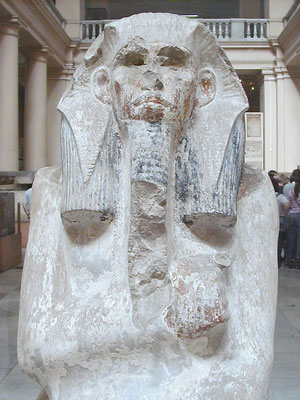
Netjerikhet (“divine of body”) ruled ancient Eypt at the beginning of the third dynasty (Old Kingdom). He is usually referred to as Djoser (Zozer or Djeser). However, this may have been his birth name, and it only appears in later records. During his reign he was called Netjerikhet, and the name Djoser was only added to his step pyramid complex during the new kingdom. His two names are recorded together in a stelae found on the isle of Sele, in Aswan. However, the stelae turned out to be a Ptolemaic forgery alleging that the surrounding area was granted to the temple by the Pharoah.
The famous painted limestone statue of Djoser found in the serdab of his step pyramid at Saqqara (and now housed in the Egyptian Museum in Cairo) is the oldest known life-sized Egyptian statue.
It is possible that his father was Khasekhemwy. Queen Nimaethap (the wife of Khasekhemwy) is mentioned on a jar, sealing dating to Djoser’s reign, on which she is called “Mother of the King of the Two Lands”. One of his wives, Hetephernebti, is mentioned on a series of boundary stela from the Step Pyramid enclosure and as far as we know Inetkawes was their only named daughter. There are also references to a third royal woman, but her name is unknown. The relationship between Djoser and his successor, Sekhemkhet, is unclear and the date of his death and the length of his reign are uncertain. According to Manetho, Djoser reigned for a short nineteen years, but the royal annals suggest that he may actually have reigned for around twenty-eight years.

His exact placing in the chronology of ancient Egypt is rather problematic. Manetho names Necherophes (Sanakhte) as the first ruler of the third dynasty while the Turin King List gives this honour to Nebka.
Djoser is often credited as the first king of the third dynasty of ancient Egypt. The Westcar Papyrus suggests that Nebka ruled after Djoser and before Huni, rather than before Djoser, and burial seals found at the entrance to the tomb of Khasekhemwy in Abydos make no mention of Nebka implying that it was Djoser who was his successor. It is also sometimes suggested that Sanakhte usurped power and that Djoser arranged the burial of Khasekhemwy after he had won power back. Either way, he seems to have inherited some internal political problems from his predecessor Sanakhte, making his achievements all the more impressive.
He sent expeditions to Sinai to establish his control and mine precious turquoise and copper; undertook major building works at Heliopolis and Gebelein; extended his control as far south as Aswan; and constructed one of the most impressive monuments of the ancient world – the Step Pyramid Complex at Saqqara. His step pyramid was the first building ever to be constructed entirely out of stone. His vizier, Imhotep, was the genius responsible for the construction of this extraordinary monument. He was worshipped in his own right in later times.
Pharaoh’s Names
Manetho; Tosorthros

Nomen; Djoser Sa (Abydos Kings List)

Nomen; Djoser (Saqqara Kings List)

Nebti; Netjerkhet (Divine of body)

Nomen; Netjerikhet Djoser

Djoser Nebu (Golden Djoser)

Nomen; Djoser it

Golden Horus name; bk nbw (Golden Falcon)
Bibliography
- Bard, Kathryn (2008) An introduction to the Archaeology of Ancient Egypt
- Dodson, A and Hilton, D. (2004) The Complete Royal Families of Ancient Egypt
- Dijk, Jacobus Van (2000) “The Amarna Period and the later New Kingdom”, in The Oxford History of Ancient Egypt Ed I. Shaw
- Dodson, A and Hilton, D. (2004) The Complete Royal Families of Ancient Egypt
- Hornung E (1999) History of Ancient Egypt
- Kemp, Barry J (1991) Ancient Egypt: Anatomy of a Civilisation
- Rice, Michael (1999) Who’s Who in Ancient Egypt
- Malek, Jaromir (2000) “The Old Kingdom”, in The Oxford History of Ancient Egypt Ed I. Shaw
- Van De Mieroop, Marc (1999) A History of Ancient Egypt
- Wilkinson, Toby (1999) Early Dynastic Egypt
- Wilkinson, Toby (2010) The Rise and Fall of Ancient Egypt
Copyright J Hill 2009